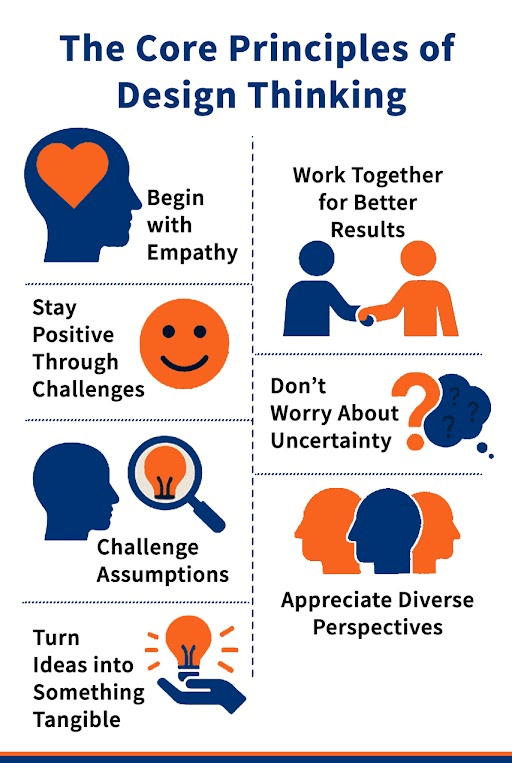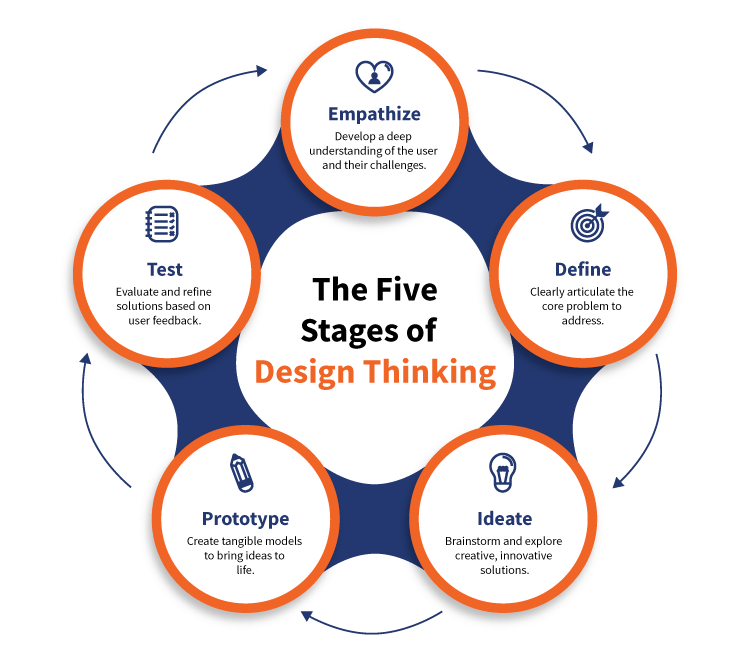What’s Design Thinking? At its core, Design Thinking is a practical way to tackle problems by focusing on the people who’ll actually use the solutions. It’s built around five straightforward steps – Empathise, Define, Ideate, Prototype, and Test, that help teams come up with ideas that really hit the mark. But the true strength lies in the principles of Design Thinking, which steer teams toward creative thinking and keep the focus on what’s most important.
Why Design Thinking is a Big Deal in Today’s Business World
Design Thinking has become a popular approach because it takes problem-solving to the next level. It lets leaders handle tough challenges by always putting users first, which is super important in industries like healthcare, tech, customer service, and beyond. For anyone looking to take on a leadership role, Design Thinking provides a solid way to create solutions that users genuinely appreciate while also meeting business needs.
What Are the Core Principles of Design Thinking?
The core principles of Design Thinking are what make this approach stand out. They’re not just a bunch of rules, they’re a way of thinking that helps teams find clever, user-focused solutions. Let’s take a closer look at the principles of Design Thinking and how they play out in real situations.
1. Begin with Empathy
Empathy is the starting point for Design Thinking. It’s all about really understanding the people being designed for by listening to what they need and what’s holding them back. For instance, when building an app for students, empathy means sitting down with them to hear about their challenges, instead of just assuming what they might need.
2. Work Together for Better Results
Design Thinking is at its best when teams collaborate. The principles of Design Thinking push for bringing together people with different skills and perspectives. Picture this: while planning a marketing campaign, gathering ideas from designers, writers, and even customer support can lead to something way more creative than going it alone.
3. Stay Positive Through Challenges
Tough problems can feel overwhelming, but keeping a positive attitude helps teams stay on track. This principle is about believing there’s always a way to work things out. If a project runs into budget troubles, a positive mindset might mean looking for free tools or coming up with a new plan to make it happen.
4. Don’t Worry About Uncertainty
Some problems don’t have obvious answers, and that’s perfectly okay. Being fine with uncertainty means teams can experiment without having everything figured out upfront. For example, when launching a new service with unclear goals, this principle lets teams test different ideas to see what works.
5. Challenge Assumptions
One of the design thinking principles is to question what’s taken for granted. Assumptions can easily lead teams in the wrong direction, so it’s important to take a step back and rethink them. For instance, if it seems employees need more training, a deeper look might reveal they actually need better tools to do their jobs.
6. Appreciate Diverse Perspectives
Having people from different backgrounds on the team helps see problems from new angles. When designing something for a global audience, a diverse team makes sure the solution works for everyone, not just a small group.
7. Turn Ideas into Something Tangible
Ideas are awesome, but they’re even better when they can be seen and felt. Making sketches or simple prototypes helps everyone get a clearer picture of the concept. For example, when working on a website, a quick sketch of the layout can make it easier to spot problems early and get feedback.
Design Thinking Mindsets: It’s More Than Just Steps
Design Thinking isn’t only about following a process, it’s also about how teams think. A mindset shapes the way challenges are tackled, how teamwork happens, and how open everyone is to new possibilities. Without the right mindset, the process can feel forced and not very effective. Here are the main mindsets that bring the principles of Design Thinking to life, with examples to show how they work in action.
- Be Empathetic: Empathy helps teams really get what users are going through. In a customer service project, this means paying attention to how customers feel, not just how quickly responses are sent.
- Be Collaborative: Teaming up leads to better ideas. When putting together a marketing strategy, working with folks from different departments can bring in some really fresh perspectives.
- Be Optimistic: A positive mindset keeps teams going strong. If a project hits a budget issue, optimism encourages finding smart workarounds, like using free resources in a new way.
- Embrace Uncertainty: It’s fine to not have all the answers right away. When working on a product with unclear goals, this mindset lets teams try out different ideas and figure out what works best.
- Be Curious: Asking questions leads to better insights. In a healthcare project, curiosity means exploring patient experiences to understand their real needs, instead of assuming.
- Rethink Assumptions: Don’t accept things at face value. In customer service, assuming users want quick fixes might miss that they’d prefer a more personal touch.
- Embrace Diversity: Different viewpoints make solutions stronger. For a global product, having team members from various cultures ensures the solution appeals to a wider audience.
- Make Ideas Tangible: Seeing is believing. In app development, sketching the interface early on helps everyone understand the concept and give useful feedback.
Goals of Design Thinking: What It Aims to Achieve
The goals of Design Thinking focus on creating solutions that work on three levels:
- Desirability (The Human Factor): Does the solution meet a real user need? It’s about making something users connect with, like a product that feels intuitive and helpful. This builds trust and keeps them engaged.
- Feasibility (The Technical Factor): Can the solution be built with the resources available? This ensures ideas are practical and won’t hit major roadblocks down the line.
- Viability (The Business Factor): Does it make sense for the business? A viable solution delivers value, whether that’s through revenue, growth, or stronger customer loyalty.
Here’s why these goals of Design Thinking matter:
- Desirability ensures the solution solves a real problem for users.
- Feasibility keeps ideas grounded in reality.
- Viability makes sure the business benefits, so efforts pay off.
Design Thinking helps teams balance these three aspects. A solution that’s desirable but not feasible won’t get off the ground. One that’s viable but not desirable might make money but won’t keep users happy. Finding the right balance is key.
The Five Stages of Design Thinking: A Clear Path to Solutions
Design Thinking breaks down into five stages that guide teams through solving problems in a smart, organized way. Each stage builds skills that are super handy for any professional.
- Empathise (Understand the User): Start by getting to know the people being designed for. Use tools like interviews or observations to uncover their challenges. This builds skills like listening carefully and understanding emotions.
- Define (Pin Down the Problem): Pull together those findings to pinpoint the exact problem to solve. This keeps the focus sharp and improves the ability to think critically.
- Ideate (Brainstorm Solutions): Brainstorm as many ideas as possible, don’t hold back! Techniques like mind mapping help teams think creatively and work together to come up with unique solutions.
- Prototype (Build Something to Test): Create simple versions of those ideas to test out. In management, this might mean building a basic product to try. It teaches resourcefulness and project management.
- Test (Tweak and Improve): Get feedback from users and make the solution better. Tools like small tests or pilot programs help teams adapt, analyze feedback, and keep improving even if things need adjusting.
Also read: Design Thinking in business education
Register Your Interest at Badruka
Why Design Thinking is a Game-Changer for Aspiring Managers
Design Thinking gives management students a serious advantage. Here’s why it’s such a big deal for those looking to lead:
- Sparks Innovation Across Industries: Big names like Google, Apple, and Procter & Gamble rely on Design Thinking to stay ahead. It helps managers understand what users need, make experiences better, and come up with fresh ideas that drive business growth.
- Builds Strong Leaders: Design Thinking teaches how to adapt, keep getting better, and tackle challenges head-on, exactly what’s needed to handle fast-moving markets and new tech trends.
- Helps Careers Take Off: Employers are always on the lookout for skills like empathy, creativity, and problem-solving. With Design Thinking, professionals really shine in leadership roles where focusing on users is key.
How Badruka’s PGDM Programme Brings Design Thinking to Life
At Badruka School of Management, the PGDM programme weaves Design Thinking right into the heart of learning. Students get to roll up their sleeves with real projects think improving customer experiences or designing new products, while using the principles of Design Thinking to guide their efforts. This hands-on approach gets them ready to lead in industries like tech, finance, healthcare, and consulting, preparing them to take on today’s challenges and shape what’s next.
Here’s what makes Badruka’s approach stand out:
- Real-World Experience: Students get to apply Design Thinking in actual business settings, making the learning experience practical.
- Teamwork in Action: Working on projects together helps build collaboration and innovation skills that are so important in the workplace.
- Focus on What Matters: The program makes sure graduates are fully prepared to step into dynamic work environments and make an impact.


